Valley grassland is the plant community native to non-riparian areas of Sutter County below approximately 50 feet, including Abbott, Catlett, Counsman, Cranmore, Cunard, East Nicolaus, Ensley, Hinsdale, Josephine, Karnak, Kirkville, Lira, Marchant, Meridian, Nicolaus, Oswald, Progress, Robbins, Sankey, Subaco, Tarke, Tisdale, Trowbridge, Tudor, Verona, and Wilson. It is defined by the absence of trees and of most shrubs. Winter flooding, extremely dry summers, and soil that tends to be somewhat alkaline make it difficult for trees and shrubs to grow. However, despite the name, native grasses or grasslike plants are usually not the dominant plants either. Before the arrival of Europeans, wildflowers were the dominant plants in the valley grassland areas. Now, ploughed farm fields and invasive weeds—primarily annual grasses from other continents—dominate most of these areas. The ecosystem's health, stability, and beauty can be greatly improved by removing the invasive grasses and planting the native wildflowers listed below.
Some of the lowest-lying areas near valley grassland become so flooded in winter that they can become vernal pools, a seasonal form of freshwater marsh. Freshwater marsh is an even more difficult environment for most types of plants than valley grassland is, and vernal pools are even more difficult than year-round freshwater marsh.
The plants listed below are native to valley grassland in Sutter County.1
Shrubs and Vines
 Naked buckwheat (Eriogonum nudum) is named for the fact that it has no leaves except for a few small ones at ground level. Photo by queerbychoice. (See the Buckwheats and Beardtongues pages for more information about some of these species.)
Naked buckwheat (Eriogonum nudum) is named for the fact that it has no leaves except for a few small ones at ground level. Photo by queerbychoice. (See the Buckwheats and Beardtongues pages for more information about some of these species.)
Herbaceous Perennials
Monocots
Grasses and Grasslike Plants
True Grasses
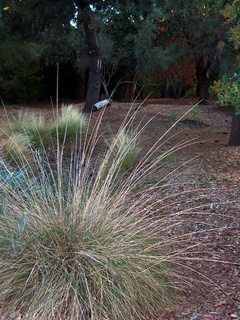 Deergrass (Muhlenbergia rigens) in the California State University Sacramento arboretum. Photo by queerbychoice. (See the Bentgrasses and Ryegrasses pages for more information about some of these species.)
Deergrass (Muhlenbergia rigens) in the California State University Sacramento arboretum. Photo by queerbychoice. (See the Bentgrasses and Ryegrasses pages for more information about some of these species.)
squirreltail ryegrass (also called bottlebrush ryegrass)
creeping wild rye (also called valley wild rye, alkali rye, or beardless wild rye)
pine bluegrass (also called one-sided bluegrass)
Sedges
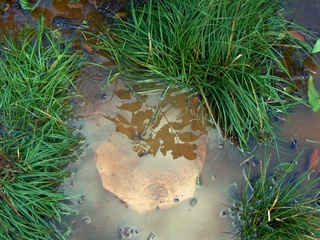 Clustered field sedge (Carex praegracilis) surrounds a submerged stepping-stone in a seasonally flooded garden in Marysville. Clustered field sedge grows very well in heavy clay soils that tend to be very dry in the summer but very wet in the winter. Photo by queerbychoice. (See the Sedges pages for more information about these and other sedge species.)
Clustered field sedge (Carex praegracilis) surrounds a submerged stepping-stone in a seasonally flooded garden in Marysville. Clustered field sedge grows very well in heavy clay soils that tend to be very dry in the summer but very wet in the winter. Photo by queerbychoice. (See the Sedges pages for more information about these and other sedge species.)
valley sedge (also called Santa Barbara sedge)
clustered field sedge (also called expressway sedge)
Rushes
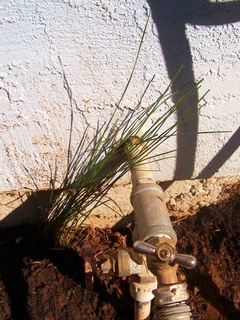 Wire rush (Juncus balticus) next to an outdoor faucet in Marysville. Photo by queerbychoice. (See the Rushes pages for more information about these and other rush species.)
Wire rush (Juncus balticus) next to an outdoor faucet in Marysville. Photo by queerbychoice. (See the Rushes pages for more information about these and other rush species.)
wire rush (also called Baltic rush)
common bog rush (also called soft rush)
Bulbs and Corms
(See the Cluster-Lilies and Tulips pages for more information about some of these species.)
harvest cluster-lily (also called elegant cluster-lily)
wavyleaf soaproot (also called amole)
death camas (also called chaparral zigadene or star lily)
Dicots
Aster Family
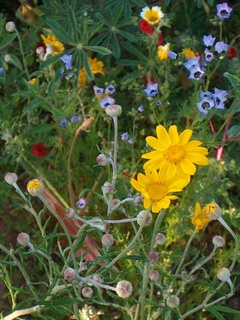 The yellow flowers and pinkish grey buds of woolly sunflower (Eriophyllum lanatum) mingle with tidytips, common goldfields, bird's eye gilyflower, and scarlet mallow in a Marysville garden. Photo by queerbychoice. (See the Daisies and Mule Ears pages for more information about some of these species.)
The yellow flowers and pinkish grey buds of woolly sunflower (Eriophyllum lanatum) mingle with tidytips, common goldfields, bird's eye gilyflower, and scarlet mallow in a Marysville garden. Photo by queerbychoice. (See the Daisies and Mule Ears pages for more information about some of these species.)
California balsamroot (also called big scale balsam root)
woolly sunflower (also called Oregon sunshine)
narrowleaf mule ears (also called California compassplant)
whitehead mule ears (also called gray mule ears)
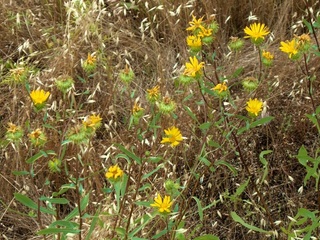 Great Valley gumplant (Grindelia camporum) on a Marysville levee. Photo by queerbychoice.
Great Valley gumplant (Grindelia camporum) on a Marysville levee. Photo by queerbychoice. 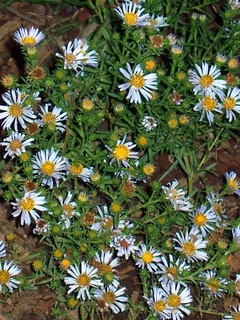 California aster (Symphyotrichum chilense) in a garden in Marysville. Photo by queerbychoice.
California aster (Symphyotrichum chilense) in a garden in Marysville. Photo by queerbychoice.
Other Plant Families
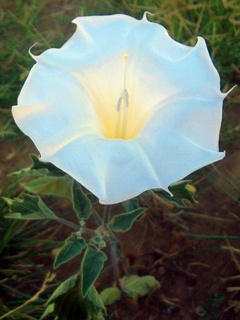 A very young sacred thornapple (Datura wrightii) in a garden in Marysville. Photo by queerbychoice. (See the Milkweeds, Larkspurs, and Lupines pages for more information about some of these species.)
A very young sacred thornapple (Datura wrightii) in a garden in Marysville. Photo by queerbychoice. (See the Milkweeds, Larkspurs, and Lupines pages for more information about some of these species.)
kotolo milkweed (also called Indian milkweed or woollypod milkweed)
narrowleaf milkweed (also called Mexican whorled milkweed)
sacred thornapple (also called toluaca)
broadleaf shooting star (also called mosquito bills)
Western wallflower (also called sand-dune wallflower or prairie rocket)
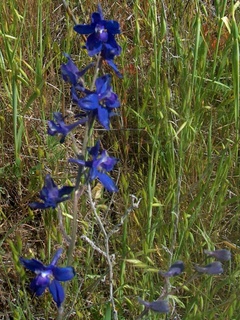 Royal larkspur (Delphinium variegatum) in Bear Valley. Photo by queerbychoice.
Royal larkspur (Delphinium variegatum) in Bear Valley. Photo by queerbychoice. 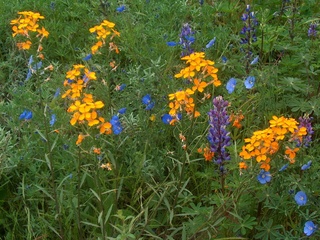 The fluorescent orange of sand-dune wallflower (Erysimum capitatum) mingles with blue flax and arroyo lupine in a garden in Marysville. Photo by queerbychoice.
The fluorescent orange of sand-dune wallflower (Erysimum capitatum) mingles with blue flax and arroyo lupine in a garden in Marysville. Photo by queerbychoice.
Ferns
 Goldenback fern (Pentagramma triangularis) prefers full shade, as most ferns do. Photo by queerbychoice. (See the Maidenhair Ferns and Wood Ferns pages for more information about these and other fern species.)
Goldenback fern (Pentagramma triangularis) prefers full shade, as most ferns do. Photo by queerbychoice. (See the Maidenhair Ferns and Wood Ferns pages for more information about these and other fern species.)
brittle bladderfern (also called fragile fern)
coffee fern (also called coffee cliffbrake)
bird's foot fern (also called bird's foot cliffbrake)
Annuals
Monocots
Grasses
prairie threeawn (also called oldfield threeawn) California bromegrass Scribner's grass Pacific fescue
Dicots
Aster Family
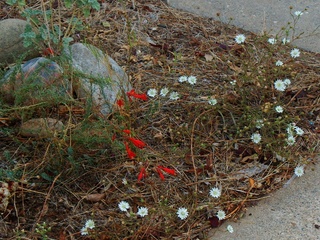 Hayfield tarweed (Hemizonia congesta) and California fuchsia in a garden in Marysville. Photo by queerbychoice. (See the Daisies, Goldfields, Tarweeds, and Tidytips pages for more information about some of these species.)
Hayfield tarweed (Hemizonia congesta) and California fuchsia in a garden in Marysville. Photo by queerbychoice. (See the Daisies, Goldfields, Tarweeds, and Tidytips pages for more information about some of these species.)
Fitch's tarweed (also called Fitch's spikeweed)
slender cottontop (also called Q-tips)
rod wirelettuce (also called twiggy wreathplant) silverpuffs
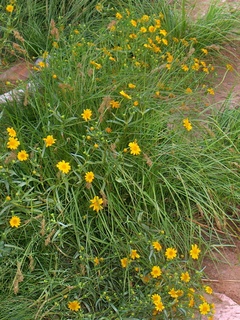 California goldfields (Lasthenia californica) mix with clustered field sedge in a garden in Marysville. Photo by queerbychoice.
California goldfields (Lasthenia californica) mix with clustered field sedge in a garden in Marysville. Photo by queerbychoice. 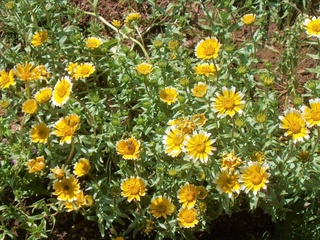 Common tidytips (Layia platyglossa) in a garden in Marysville. Photo by queerbychoice.
Common tidytips (Layia platyglossa) in a garden in Marysville. Photo by queerbychoice.
Borage Family
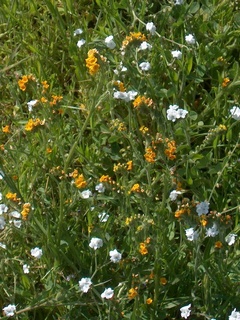 Smallflower fiddleneck (Amsinckia menziesii) and unidentified popcornflowers on Table Mountain. Photo by queerbychoice. (See the Phacelias page for more information about some of these species.)
Smallflower fiddleneck (Amsinckia menziesii) and unidentified popcornflowers on Table Mountain. Photo by queerbychoice. (See the Phacelias page for more information about some of these species.)
sleeping combseed (also called winged combseed)
common distant phacelia (also called wild heliotrope)
tansyleaf phacelia (also called lacy phacelia)
Mustard Family
sand fringepod (also called hairy lacepod)
mountain fringepod (also called common narrowleaf lacepod)
ribbed fringepod (also called showy fringepod)
Pea Family
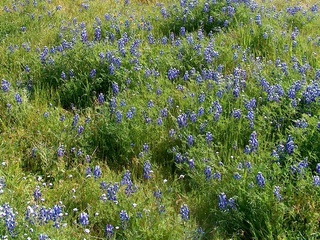 Sky lupine (Lupinus nanus) on Table Mountain. Photo by queerbychoice. (See the Deervetches, Lupines, and Clovers pages for more information about some of these species.)
Sky lupine (Lupinus nanus) on Table Mountain. Photo by queerbychoice. (See the Deervetches, Lupines, and Clovers pages for more information about some of these species.)
dwarf white milkvetch (also called twoseed milkvetch)
foothill shortpod deervetch (also called colchita)
desert smallflower trefoil (also called San Diego deervetch)
Chilean bird's foot trefoil (also called calf deervetch)
chick lupine (also called valley lupine)
arroyo lupine (also called hollowleaf annual lupine or succulent lupine)
pinpoint clover (also called graceful clover)
hairy maiden clover (also called smallhead field clover)
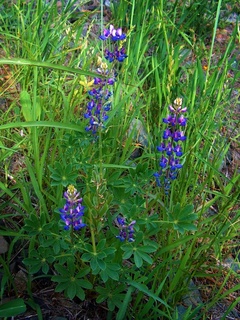 Arroyo lupine (Lupinus succulentus) on a levee in Marysville. Photo by queerbychoice.
Arroyo lupine (Lupinus succulentus) on a levee in Marysville. Photo by queerbychoice. 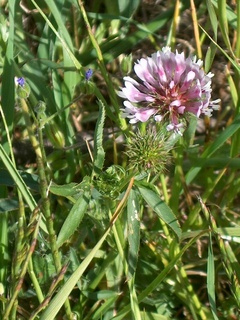 Tomcat clover (Trifolium willdenovii) in flower and bud on Table Mountain. Photo by queerbychoice.
Tomcat clover (Trifolium willdenovii) in flower and bud on Table Mountain. Photo by queerbychoice.
Evening-Primrose Family
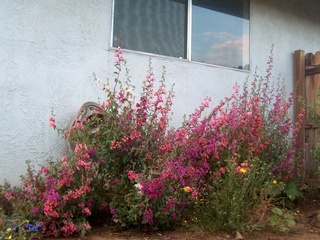 Mountain garland (Clarkia unguiculata) explodes in shades of pink, reddish purple, and white in early May in a garden in Marysville. Photo by queerbychoice. (See the Clarkias and Willowherbs pages for more information about some of these species.)
Mountain garland (Clarkia unguiculata) explodes in shades of pink, reddish purple, and white in early May in a garden in Marysville. Photo by queerbychoice. (See the Clarkias and Willowherbs pages for more information about some of these species.)
winecup clarkia (also called purple clarkia)
elegant clarkia (also called woodland clarkia or mountain garland)
denseflower willowherb (also called denseflower spike-primrose)
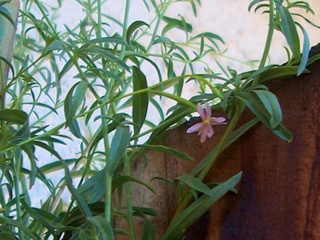 Tall autumn willowherb (Epilobium brachycarpum) blooms next to a six-foot-tall fence in Marysville. Photo by queerbychoice.
Tall autumn willowherb (Epilobium brachycarpum) blooms next to a six-foot-tall fence in Marysville. Photo by queerbychoice.
Phlox Family
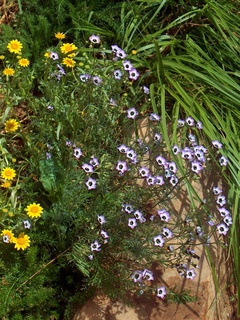 Bird's eye gilyflower (Gilia tricolor) and California goldfields in a garden in Marysville. Photo by queerbychoice.
Bird's eye gilyflower (Gilia tricolor) and California goldfields in a garden in Marysville. Photo by queerbychoice.
Other Families
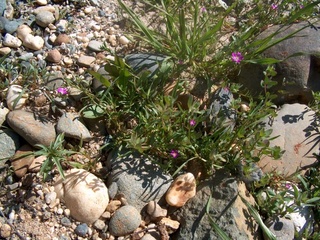 Red maids (Calandrinia ciliata) bloom among river rocks at Parks Bar. Photo by queerbychoice. (See the Monkeyflowers and Paintbrushes pages for more information about some of these species.)
Red maids (Calandrinia ciliata) bloom among river rocks at Parks Bar. Photo by queerbychoice. (See the Monkeyflowers and Paintbrushes pages for more information about some of these species.)
valley tassels (also called narrowleaf owl's clover)
Contura Creek sandmat (also called Contura Creek spurge)
thymeleaf sandmat (also called thymeleaf spurge)
little serpentine springbeauty
common bluecup (also called Venus' looking glass)
Douglas' stitchwort (also called Douglas' sandwort)
johnnytuck (also called butter 'n' eggs)
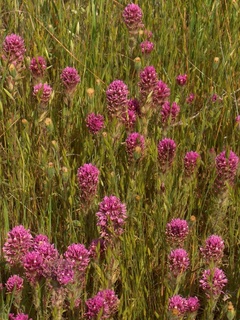 Purple owl's clover (Castilleja exserta) in Bear Valley. Photo by queerbychoice.
Purple owl's clover (Castilleja exserta) in Bear Valley. Photo by queerbychoice. 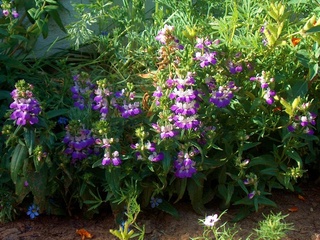 Purple Chinese pagodas (Collinsia heterophylla) in a garden in Marysville. Photo by queerbychoice.
Purple Chinese pagodas (Collinsia heterophylla) in a garden in Marysville. Photo by queerbychoice. 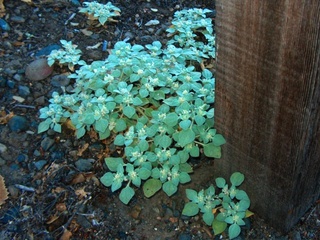 Doveweed (Croton setigerus) blooms next to a post in the American River Parkway. Photo by queerbychoice.
Doveweed (Croton setigerus) blooms next to a post in the American River Parkway. Photo by queerbychoice. 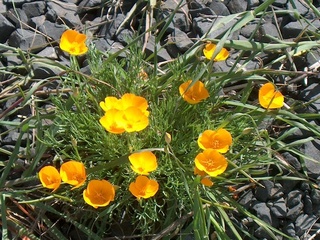 Foothill tufted poppy (Eschscholzia caespitosa) blooms in gravel on Table Mountain. This plant is closely related to the more familiar California poppy and looks like a miniature version of it (about half as big). Photo by queerbychoice.
Foothill tufted poppy (Eschscholzia caespitosa) blooms in gravel on Table Mountain. This plant is closely related to the more familiar California poppy and looks like a miniature version of it (about half as big). Photo by queerbychoice. 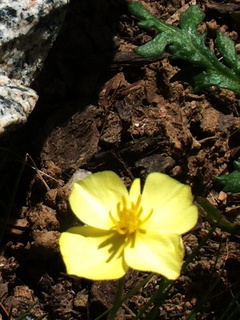 A frying pan (Eschscholzia lobbii) blooms in a garden in Marysville. This plant is closely related to the more familiar California poppy. Photo by queerbychoice.
A frying pan (Eschscholzia lobbii) blooms in a garden in Marysville. This plant is closely related to the more familiar California poppy. Photo by queerbychoice. 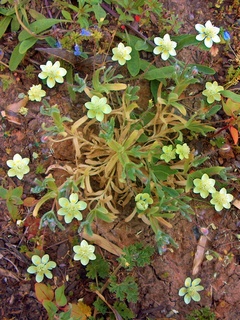 Cream cups (Platystemon californicus) in a garden in Marysville, with the blue flowers of Sonoma sage and a blue bud of baby blue eyes. Photo by queerbychoice.
Cream cups (Platystemon californicus) in a garden in Marysville, with the blue flowers of Sonoma sage and a blue bud of baby blue eyes. Photo by queerbychoice. 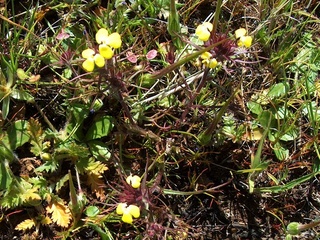 Butter 'n' eggs (Triphysaria eriantha) on Table Mountain. Photo by queerbychoice.
Butter 'n' eggs (Triphysaria eriantha) on Table Mountain. Photo by queerbychoice.
Footnotes
1. CalFlora.org


